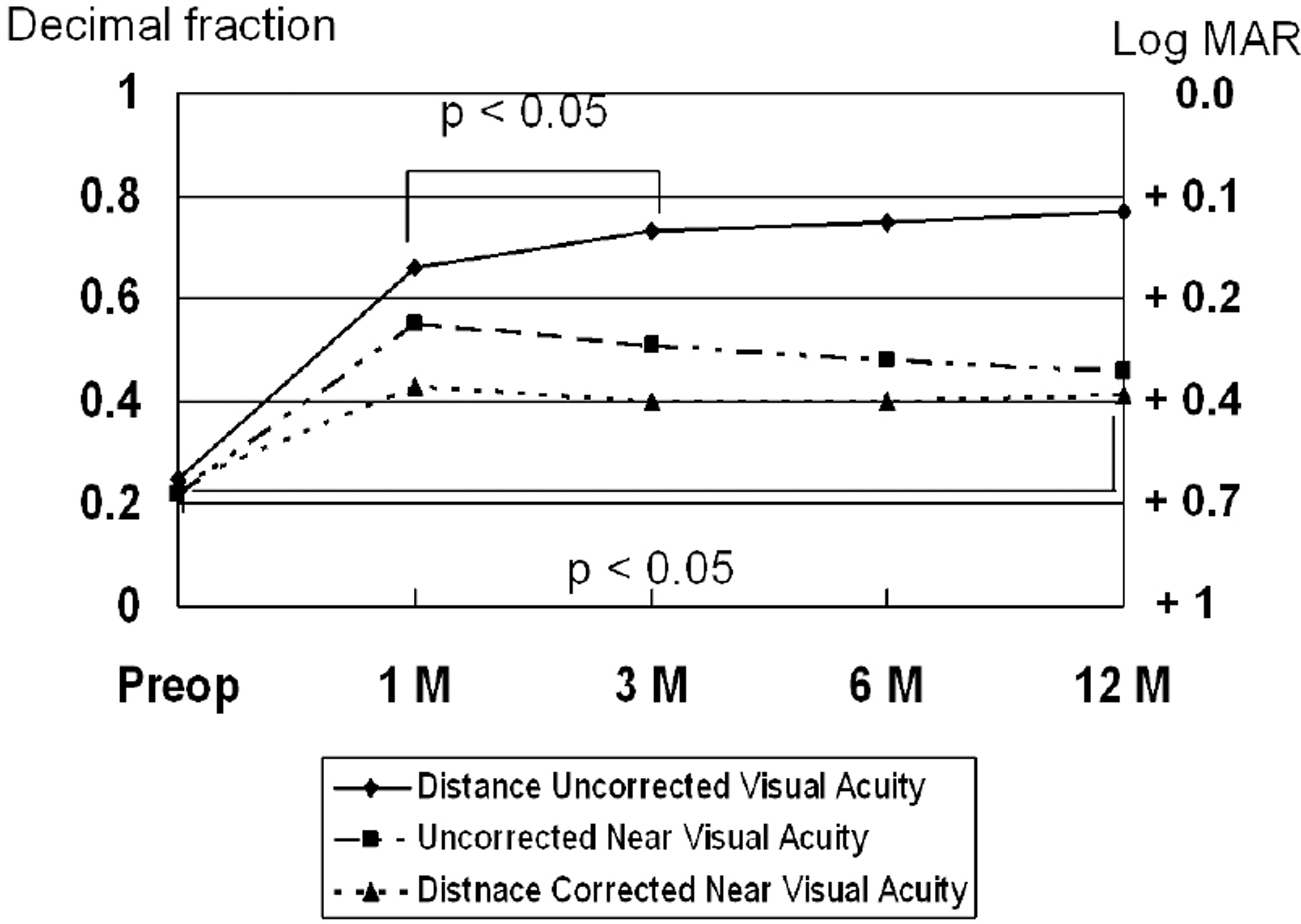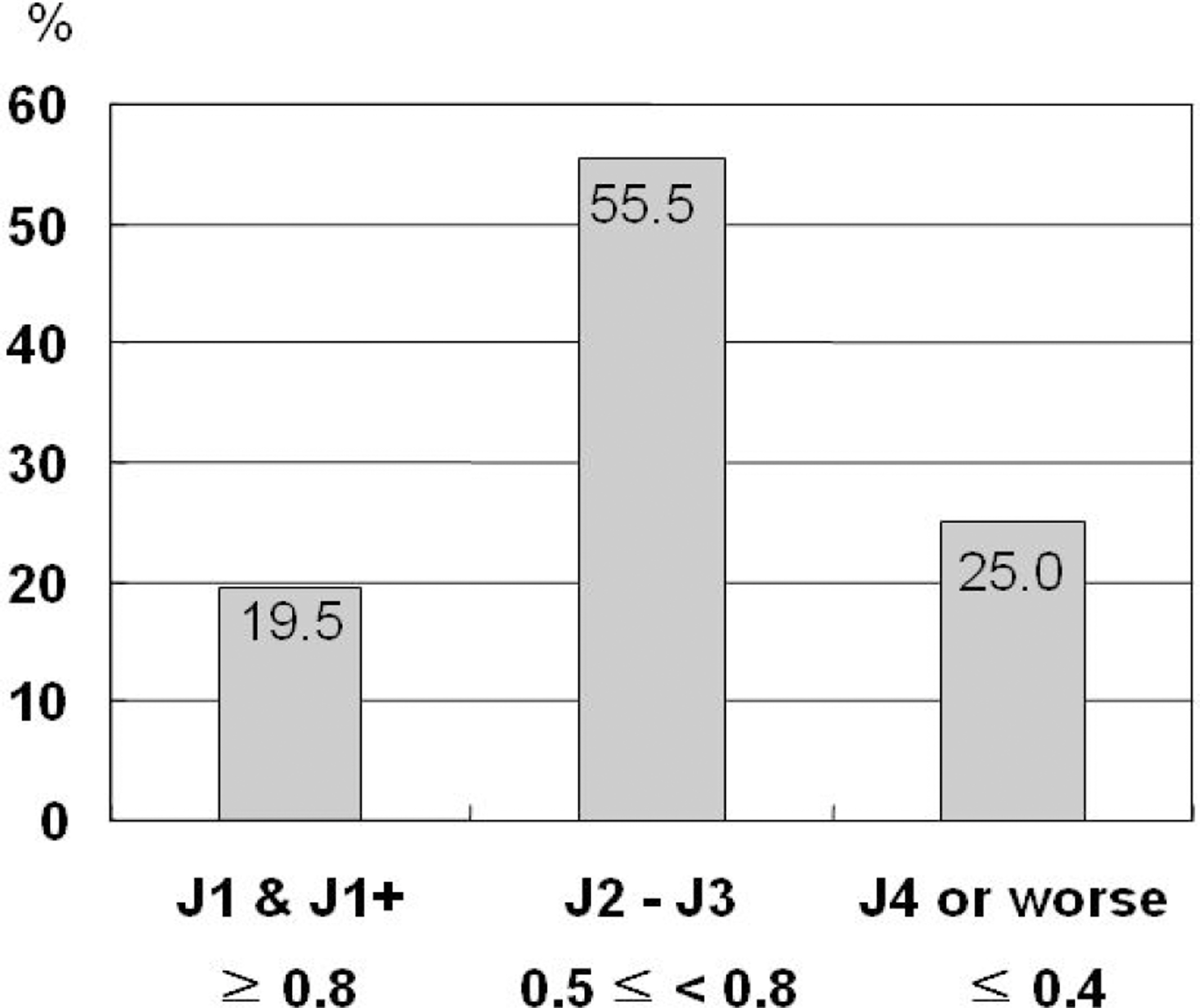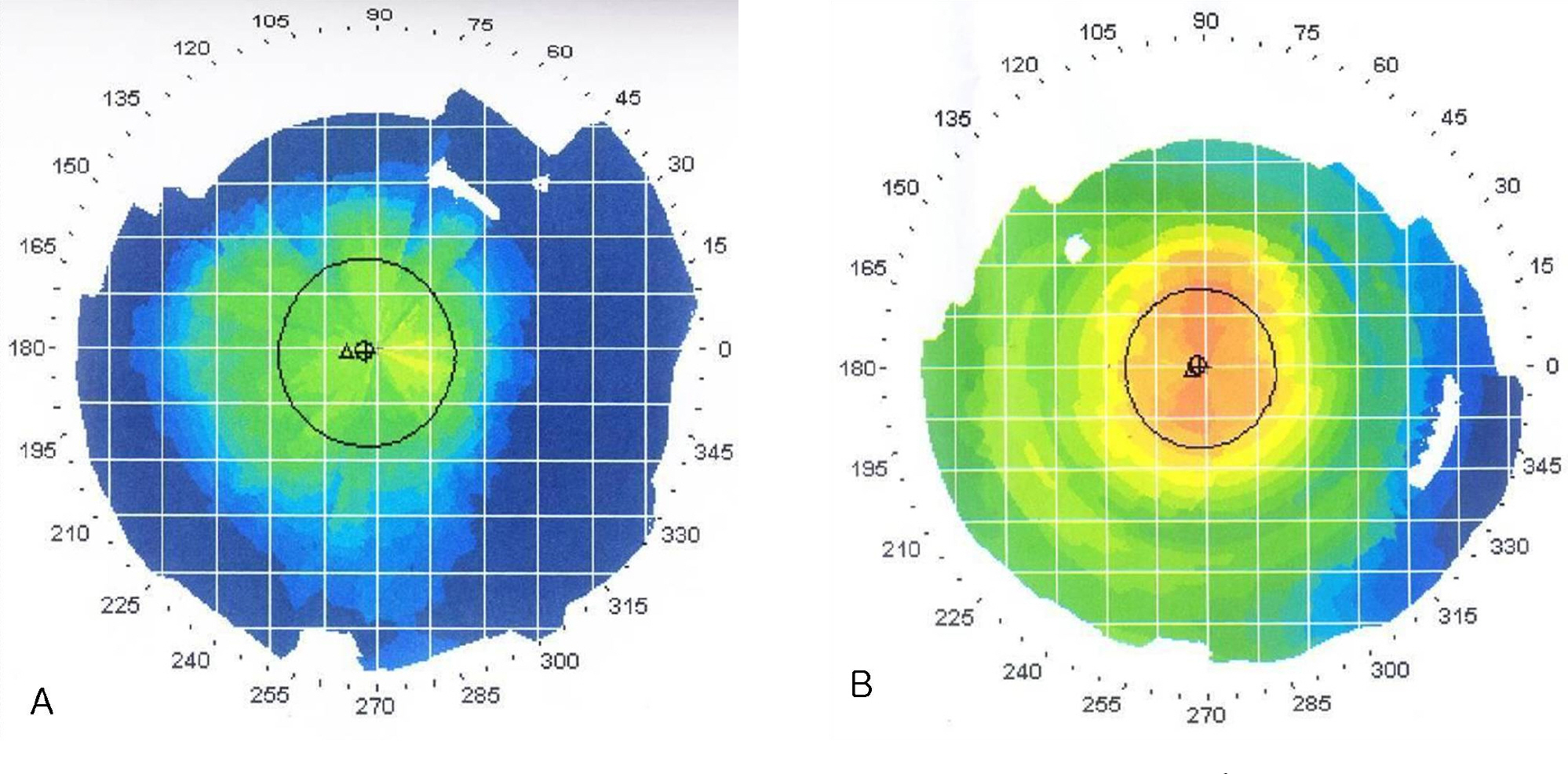J Korean Ophthalmol Soc.
2008 Jul;49(7):1061-1070. 10.3341/jkos.2008.49.7.1061.
Long-Term Results of Presbyopic Corneal Surface Ablation with Eximer Laser
- Affiliations
-
- 1Department of Ophthalmology, Chung-Ang University Yongsan Hospital, Seoul, Korea. jck50ey@kornet.net
- 2GM Eye Clinic, Seoul, Korea.
- KMID: 1476959
- DOI: http://doi.org/10.3341/jkos.2008.49.7.1061
Abstract
-
PURPOSE: To evaluate the efficacy, safety, and subjective symptoms of patients who underwent presbyopic corneal surface ablation.
METHODS
Excimer laser surgery with MEL80 for refractive errors and presbyopia was performed on 128 eyes of 67 patients. Uncorrected and best-corrected visual acuity, distance-corrected near-visual acuity, spectacle near-addition for Jaeger 1, depth of focus, spherical aberration, and subjective symptoms were evaluated before surgery and 1 year after surgery.
RESULTS
This study consisted of a myopia group (56 eyes), an emmetropia group (spherical equivalent < or = +/-0.75D, 19 eyes), and a hyperopia group (53 eyes). Presbyopic corneal ablation improved distance and near uncorrected visual acuity, and distance-corrected near visual acuity at postoperative 12 months. There was no significant change in best-corrected visual acuity but there was a significant decrease in the emmetropia only group. Useful near visual acuity (> or =20/40) was found in 96 eyes (75%) and spectacle near addition for Jaeger 1 decreased. Our results showed a significant increase of spherical aberration (from -0.19 micrometer to 0.11 micrometer) and depth of focus (from 1.45D to 1.69D). A significant positive correlation was found between spherical aberration and uncorrected far and near visual acuity and depth of focus. Loss of two lines of best corrected visual acuity occurred in 11 eyes (8.5%) at far vision and in 7 eyes (5.5%) at near vision. In general, patient satisfaction was good.
CONCLUSIONS
Presbyopic corneal ablation with MEL80 showed good distant and near visual results and a wide depth of focus induced by increased spherical aberration.
Keyword
MeSH Terms
Figure
Cited by 1 articles
-
LASIK for Myopia with Presbyopia Using the Aspheric Micro-Monovision Technique
Kunho Bae, Ji Eun Keum, Tae-Young Chung, Eui-Sang Chung
J Korean Ophthalmol Soc. 2012;53(1):11-19. doi: 10.3341/jkos.2012.53.1.11.
Reference
-
References
1. Duane A. A modified accommodation line and Prince's rule. Trans Am Ophthalmol Soc. 1921; 19:178–9.2. Trindade F, Oliverira A, Frasson M. Benefit of against-the rule astigmatism to uncorrected near acuity. J Cataract Refract Surg. 1997; 23:82–5.3. Fukuyama M, Oshika T, Amano S, Yoshitomi F. Relationship between apparent accommodation and corneal multifocality in pseudophakic eyes. Ophthalmology 1999;106:1178-81. 4.)Hersh PS. Optics of conductive keratoplasty: implications for presbyopia management. Trans Am Ophthalmol Soc. 2005; 103:412–56.5. Oshika T, Mimura T, Tanaka S. . Apparent accommodation and corneal wavefront aberration in pseudophakic eyes. Invest Ophthalmol Vis Sci. 2002; 43:2882–6.6. Alió JL, Chaubard JJ, Caliz A. . Correction of presbyopia by technovision central multifocal LASIK (presbyLASIK). J Refract Surg. 2006; 22:453–60.
Article7. Artola A, Patel S, Schimchak P. . Evidence for delayed presbyopia after photorefractive keratectomy for myopia. Ophthalmology. 2006; 113:735–41.
Article8. Ares J, Flores R, Bará S, Jaroszewicz Z. Presbyopia compen -sation with a quartic axicon. Optom Vis Sci. 2005; 82:1071–8.9. Nio YK, Jansonius NM, Wijdh RH. . Effect of methods of myopia correction on visual acuity, contrast sensitivity, and depth of focus. J Cataract Refract Surg. 2003; 29:2082–95.
Article10. Vinciguerra P, Nizzola GM, Nizzola F. . Zonal photoref -ractive keratectomy for presbyopia. J Refract Surg. 1998; 14:218–21.11. Bauerberg JM. Centered vs. inferior off-center ablation to correct hyperopia and presbyopia. J Refract Surg. 1999; 15:66–9.12. Williams DK. One-year results of laser vision correction for low to moderate hyperopia. Ophthalmology. 2000; 107:72–5.
Article13. Chylack LT Jr, Leske MC, Sperduto R. . Lens opacities classification system, version III (LOCS III). Arch Ophthalmol. 1993; 111:831–6.14. Ostrin LA, Glasser A. Accomodation measurements in a pre- presbyopic and prebyopic population. J Cataract Refract Surg. 2004; 30:1435–44.15. Heatley CJ, Spalton DJ, Boyce JF, Marshall J. A mathematical model of factors that influence the performance of accommodative intraocular lenses. Ophthalmic Physiol Opt. 2004; 24:111–8.16. Kaufman PL. Scleral expansion surgery for presbyopia. Ophthalmology. 2001; 108:2161–2.
Article17. Hamilton DR, Davidorf JM, Maloney RK. Anterior ciliary sclerotomy for treatment of presbyopia: a prospective controlled study. Ophthalmology. 2002; 109:1970–6.18. Nijkamp MD, Dolders MG, de Brabander J. . Effectiveness of multifocal intraocular lenses to correct presbyopia after cataract surgery: a randomized controlled trial. Ophthalmology. 2004; 111:1832–9.
Article19. Goldberg JB. Basic principles of aspheric contact lenses. Contact Lens Forum. 1998; May. 35–8.20. Haw WW, Manche EE. Conductive keratoplasty and laser thermal keratoplasty. Int Ophthalmol Clin. 2002; 42:99–106.
Article21. Ninomiya S, Fujikado T, Kuroda T. . Changes of ocular aberration with accommodation. Am J Ophthalmol. 2002; 134:924–6.
Article22. Cantu R, Rosales MA, Tepichin E. . Advanced surface ablation for presbyopia using the Nidek EC-5000 laser. J Refract Surg. 2004; 20:S711–3.
Article23. Cantú R, Rosales MA, Tepichín E. . Objective quality of vision in presbyopic and non-presbyopic patients after pseudoaccommodative advanced surface ablation. J Refract Surg. 2005; 21:603–5.
Article24. Plainis S, Ginis HS, Pallikaris A. The effect of ocular aberrations on steady-state errors of accommodative response. J Vis. 2005; 5:466–77.
Article25. Nishi T, Nawa Y, Ueda T. . Effect of total higher-order aberrations on accommodation in pseudophakic eyes. J Cataract Refract Surg. 2006; 32:1643–9.
Article26. Oshika T, Okamoto C, Samejima T. . Contrast sensitivity function and ocular higher-order wavefront aberrations in normal human eyes. Ophthalmology. 2006; 113:1807–12.
Article27. Holladay JT, Van Dijk H, Lang A. . Optical performance of multifocal intraocular lenses. J Cataract Refract Surg. 1990; 16:413–22.
Article28. Ravalico G, Parentin F, Sirotti P, Baccara F. Analysis of light energy distribution by multifocal intraocular lenses through an experimental optical model. J Cataract Refract Surg. 1998; 24:647–52.
Article29. Yasuda A, Yamaguchi T. Steepening of corneal curvature with contraction of the ciliary muscle. J Cataract Refract Surg. 2005; 31:1177–81.
Article30. Glasser A, Troilo D, Howland HC. The mechanism of corneal accommodation in chicks. Vision Res. 1994; 34:1549–66.
Article
- Full Text Links
- Actions
-
Cited
- CITED
-
- Close
- Share
- Similar articles
-
- Corneal Endothelial Permeability after Deep Excimer Laser Ablation
- Influence of Surface Fluid during Photorefractive Keratectomy Using a 213-nm Solid-State Laser
- Corneal Endothelial Damage after Deep Excimer Laser Ablation
- The Comparison of Corneal Ablation Amount by MEL-60 Excimer Laser and Schwind Multiscan Excimer Laser Systems
- Nine-Year Results of Excimer Laser Photorefractive Keratectomy for Myopia









